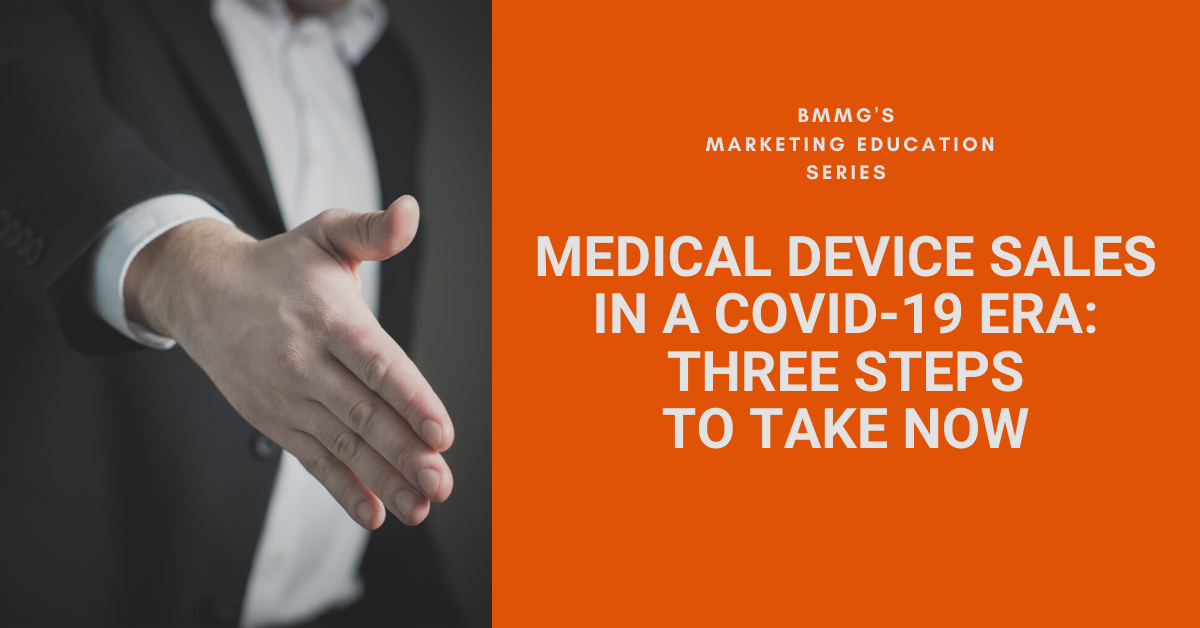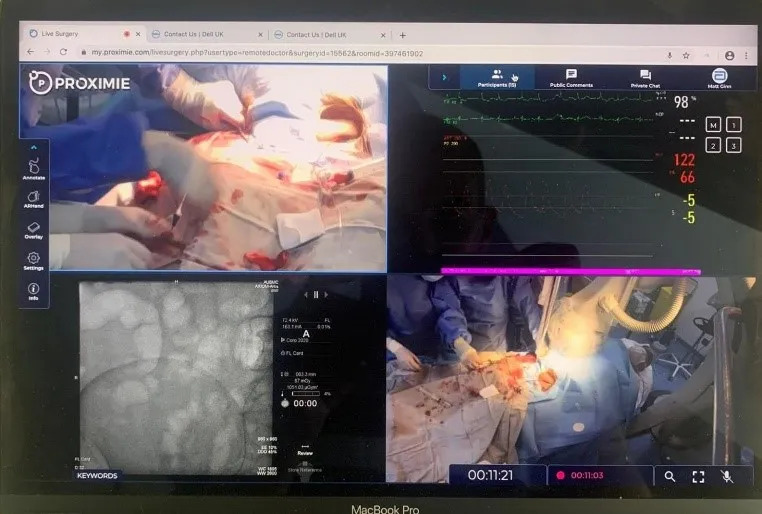Medical Device Sales in a COVID-19 Era: Three Steps to Take Now
Amid the COVID-19 pandemic, workforces across the country are adjusting to stay-at-home and social distancing orders. For medical device sales representatives – many of whom typically spend up to four or five day a week in doctors’ offices, hospitals and clinics – this presents unique obstacles that will likely linger for many months to come.
How medical device companies interact with health care professionals (HCPs) and institutions will be significantly different for at least the next 6-12 months. And while the post-pandemic landscape is yet to be determined, you should anticipate a longer-term shift towards more virtual interactions with customers.

“COVID-19 is a major, disruptive event,” explains Ted Newill, Medical Device Success, in a recent podcast, Medical Device Success: The Future of the Medical Device Industry in the Covid-19 Era. “The sales role is going to change. The sales process is going to change. Sales teams will need new tools and training to be able to work in this new environment.”
We spoke to a variety of experts – from renowned industry strategists to medical device executives and physicians – to compile the following information for what sales teams can do now to remain productive and relevant, as well as begin preparations for the future.
See below for suggestions around using technology to engage customers, leveraging virtual platforms for case support, and revamping your sales program for a more digital-centric era.
- Use Technology (More) to Engage Customers.
In many medical device industries, now is an optimal time to reach out to prospects and existing customers. With institutions limiting non-essential procedures, your targets may have extra time and be more receptive to talking to you.
Whether you send an email or make a phone call, the first rule of thumb is to be sensitive in everything you say and do. Understand, regardless of specialty or geographic location, the entire healthcare industry is under attack. Ask, flat out, is now a good time? Offer assistance from a ‘we’re in this together’ standpoint. Establish a reasonable and respectful cadence for a regular communication.
We talked to Dr. Sri Komanduri, a gastroenterologist from Northwestern Medical in Chicago, to get a physician’s perspective about how medical device companies can best work with their physician customers at this time.
“It is still a good time for reaching out [to customers],” assures Dr. Komanduri, who advises medical device representatives to “put yourself out there and let them come to you.”
Dr. Komanduri noted physicians are very interested in education but aren’t getting that stimulation right now – it could be a huge opportunity for medical device reps. “There is a tempering that needs to happen though,” says Komanduri. “There is a fine line between teaching/education and sales, and the focus really needs to be on the educational aspects [of disease states, clinical data, best practices in patient care].”

Join Dr. Komanduri on Friday, April 24 at 4:00 p.m. ET for Reactivation of the Endoscopy Lab: The New Normal for Endoscopy & Industry – a live panel discussion and Q&A covering lessons learned, operational pearls and suggestions for reactivating the endoscopy unit. The discussion will be held via the EndoscopyNow application that can be downloaded for free from the Apple App Store or Google Play. If you aren’t able to join the live webcast, take advantage of the replay option.
FaceTime, Skype and other video chat applications are great for quick touches, and well … chats. But, to the extent possible, leverage a more robust videoconferencing software to share new clinical evidence, new features/benefits, expanded indications, etc. Visual platforms such as Zoom, GoToMeeting or Microsoft Teams will allow you to share data, case footage, images, slide decks, etc. to make the most out of your meeting.
As people begin to see how simple, yet productive, videoconferencing can be – even for longer meetings typically held in-person – there is strong potential for a permanent shift in thinking around in-person versus videoconference meetings and events.
If you have any upcoming users’ meetings, roundtables, focus groups or trainings planned for 2020, make plans now to convert them to a virtual platform. Better yet, think strategically and proactively – there has never been a better time for many segments of the industry to bring together current and prospective customers through high-value, high-touch virtual user meetings.
Invite a small group of physicians (new or prospective customers) to hear from an existing KOL customer about relevant disease states, industry trends, clinical data, and case studies. Keys to remember: 1) cultivate exclusivity through limited registration of no more than five or six participants and, 2) offer valuable, peer-driven content (not just product marketing) that is clinically focused.
Please see The Art of Hosting Virtual Meetings: Adaptation and Differentiation in the New World of Virtual Meetings for best-practice strategies that will set you apart from the competition.
- Leverage Virtual Platforms to Support Procedures.
Finding ways to safely and effectively support live procedures is likely one of the biggest challenges for medical device reps who would have previously been onsite to guide or troubleshoot. Addressing this critical function is imperative, understanding there may be an extended period of time in which non-HCPs aren’t allowed in hospitals or procedure rooms.
A vast majority of colonoscopies are considered elective at this time and most have been postponed. However, a recent case at a large hospital in Baltimore called for an immediate colonoscopy and virtual assistance from a representative at Motus GI.
“In this instance, the patient who needed an immediate colonoscopy had an inadequately prepped bowel for the procedure,” explained Jeff Hutchison, vice president of sales and commercial operations.
The physician chose to use Motus GI’s Pure-Vu® System that uses water and air to safely evacuate debris from the colon mucosa, clearing the way for the endoscopist to perform a quality examination. “Without Pure-Vu, the patient’s colonoscopy would have been rescheduled, prolonging his stay in the hospital,” says Hutchison. “We were able to successfully use Zoom to assist with product set up and procedural oversight.”
For a more robust, longer-term solution, Proximie offers a HIPAA and GDPR-compliant interface that allows real-time collaboration from anywhere in the world.
Last week, an interventional cardiologist at the American University of Beirut Medical Center remotely collaborated with an expert interventional cardiologist in Copenhagen and several representatives from Abbott in the United States. The result was a successful transcatheter aortic valve implantation (TAVI).
Proximie was launched in 2016 for just this purpose,” explains Rob Doebelin, vice president of commercial operations at Proximie. “Our platform enables clinician to clinician proctoring, as well as industry and clinician collaboration, from literally anywhere in the world.”
Proximie is software-based, allowing a remote expert to simply log into the Proximie session via standard computer, laptop or phone. The remote expert can see and hear everything occurring in the procedure room, and contribute with live annotation on the operative view.
“Incorporating Proximie into routine or complex clinical practices can seamlessly maximize healthcare resources, scale the delivery of expertise, and ultimately ensure that every single patient has access to the best possible care, regardless of where they are in the world,” says Doebelin.

At BMMG, we greatly understand the timeliness of this important topic. Watch for an upcoming post that will delve into additional virtual solutions, including Avail Medsystems, ExplORer, and various AR display glasses, as well as some of the more familiar platforms, such as Zoom, Skype and Facetime. Are there other tools you are using or strategies you are implementing to support cases? We’d love to hear from you!
- Review Your Sales Programs with a Digital Lens.
Face-to-face customer interactions are a big part of a sales rep’s job, whether prospecting, assessing interest or nurturing existing relationships. In person, you can pull sell sheets out of your bag, share indications and clinical data, give product demonstrations, ask and answer questions, gauge body language and facial expressions, identify obstacles, and meet other key stakeholders. Eliminating these personal interactions creates an enormous gap in a sales reps’ toolkit.
“If you think of a sales representative’s opportunities to reach customers as a three-legged stool, you will see why enhancing your digital sales program right now is so critical,” says Lisa Bichsel, market development and strategy, Bichsel Medical Marketing Group.
“One leg is conferences and tradeshows, providing demonstrations and generating leads. Another is being onsite at hospitals and clinics, having conversations and supporting cases,” says Bichsel. The third leg, she explains, is what we are left with – the virtual touches we make through email, phone and internet. “Two of our three stool legs are broken, and we need to figure out how to re-balance our stool.”
Sales and marketing teams should work together to assess current programs and materials – everything from prospecting the ideal customer to providing in-service training and case support. How can you leverage existing content to make it more accessible and available to customers without physically handing it to them? What technology do you already use and what should you add? How can you make your static marketing materials come alive in a digital environment?

To get you started, we offer the following tactics for you to implement quickly:
- Email Marketing – if you aren’t already in front of customers and prospects through regular email communication, now is the time. Summarize what is useful for them with a clear call to action and engaging subject line.
- Interactive Media – repurpose existing content into explainer videos, infographics or podcasts. Consider sharing videos and cases you may have distributed previously but are still relevant.
- Social Media – be visible and relevant. Anything new you have (a case study, small group in-service, new indication), tout it on social media. Take the time now to engage in more frequent educational posts and consider advertising on social platforms, as costs have recently become more affordable.
Summary
No one can be certain how long the COVID pandemic will limit our direct access to healthcare professionals. We can only guess at the longer-term impact to our standard ways of interfacing with our customers and achieving our goals of generating demand and securing new business. What we do know and can control is the here and now.
Take this time to demonstrate utility and relevance to your customers in a virtual manner, so you are assured a welcome reception and warm handshake when things hopefully return to normal.